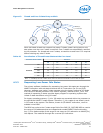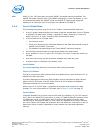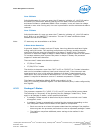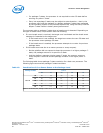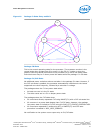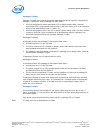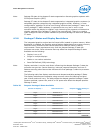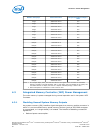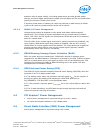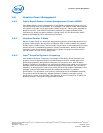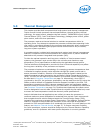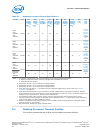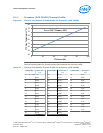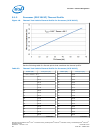
• Reduced possible overshoot/undershoot signal quality issues seen by the
processor I/O buffer receivers caused by reflections from potentially un-
terminated transmission lines.
When a given rank is not populated, the corresponding chip select and CKE signals are
not driven.
At reset, all rows must be assumed to be populated, until it can be determined that
the rows are not populated. This is due to the fact that when CKE is tri-stated with an
SO-DIMM present, the SO-DIMM is not ensured to maintain data integrity.
CKE tristate should be enabled by BIOS where appropriate, since at reset all rows
must be assumed to be populated.
DRAM Power Management and Initialization
The processor implements extensive support for power management on the SDRAM
interface. There are four SDRAM operations associated with the Clock Enable (CKE)
signals, which the SDRAM controller supports. The processor drives four CKE pins to
perform these operations.
The CKE is one of the power-save means. When CKE is off, the internal DDR clock is
disabled and the DDR power is reduced. The power-saving differs according to the
selected mode and the DDR type used. For more information, refer to the IDD table in
the DDR specification.
The processor supports three different types of power-down modes in package C0.
The different power-down modes can be enabled through configuring
"PM_PDWN_config_0_0_0_MCHBAR". The type of CKE power-down can be configured
through PDWN_mode (bits 15:12) and the idle timer can be configured through
PDWN_idle_counter (bits 11:0). The different power-down modes supported are:
• No power-down (CKE disable)
• Active power-down (APD): This mode is entered if there are open pages when
de-asserting CKE. In this mode the open pages are retained. Power-saving in this
mode is the lowest. Power consumption of DDR is defined by IDD3P. Exiting this
mode is defined by tXP – small number of cycles. For this mode, DRAM DLL must
be on.
• PPD/DLL-off: In this mode the data-in DLLs on DDR are off. Power-saving in this
mode is the best among all power modes. Power consumption is defined by
IDD2P1. Exiting this mode is defined by tXP, but also tXPDLL (10–20 according to
DDR type) cycles until first data transfer is allowed. For this mode, DRAM DLL
must be off.
The CKE is determined per rank, whenever it is inactive. Each rank has an idle-
counter. The idle-counter starts counting as soon as the rank has no accesses, and if
it expires, the rank may enter power-down while no new transactions to the rank
arrives to queues. The idle-counter begins counting at the last incoming transaction
arrival.
It is important to understand that since the power-down decision is per rank, the IMC
can find many opportunities to power down ranks, even while running memory
intensive applications; the savings are significant (may be few Watts, according to the
DDR specification). This is significant when each channel is populated with more
ranks.
4.3.2
Power Management—Processor
Desktop 4th Generation Intel
®
Core
™
Processor Family, Desktop Intel
®
Pentium
®
Processor Family, and Desktop Intel
®
Celeron
®
Processor Family
December 2013 Datasheet – Volume 1 of 2
Order No.: 328897-004 61



